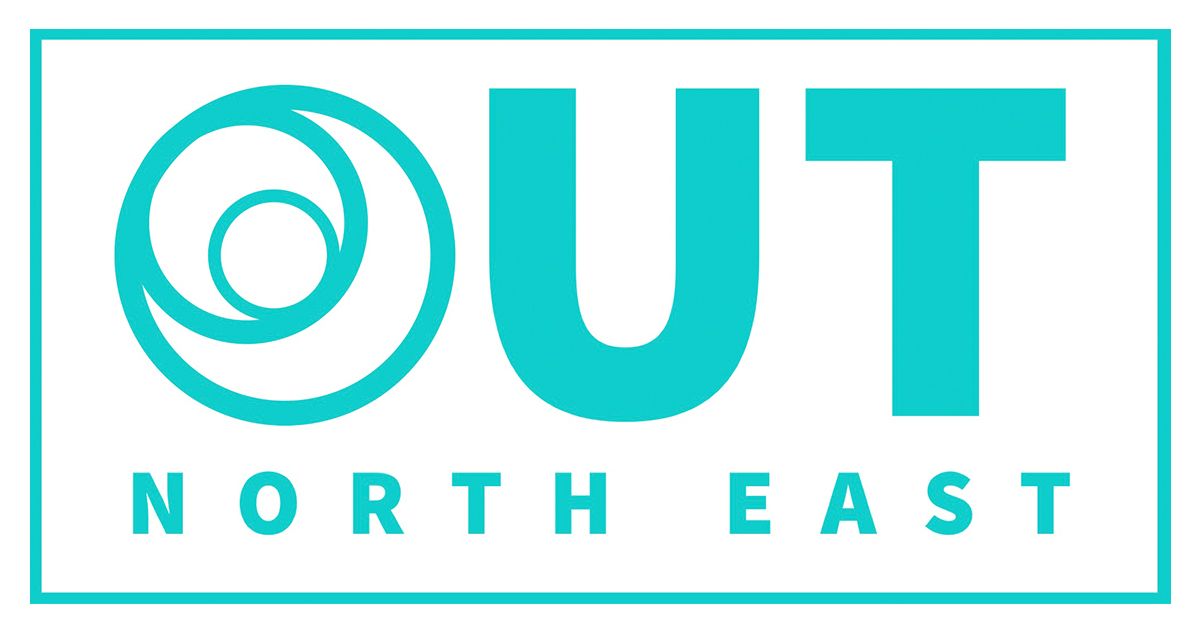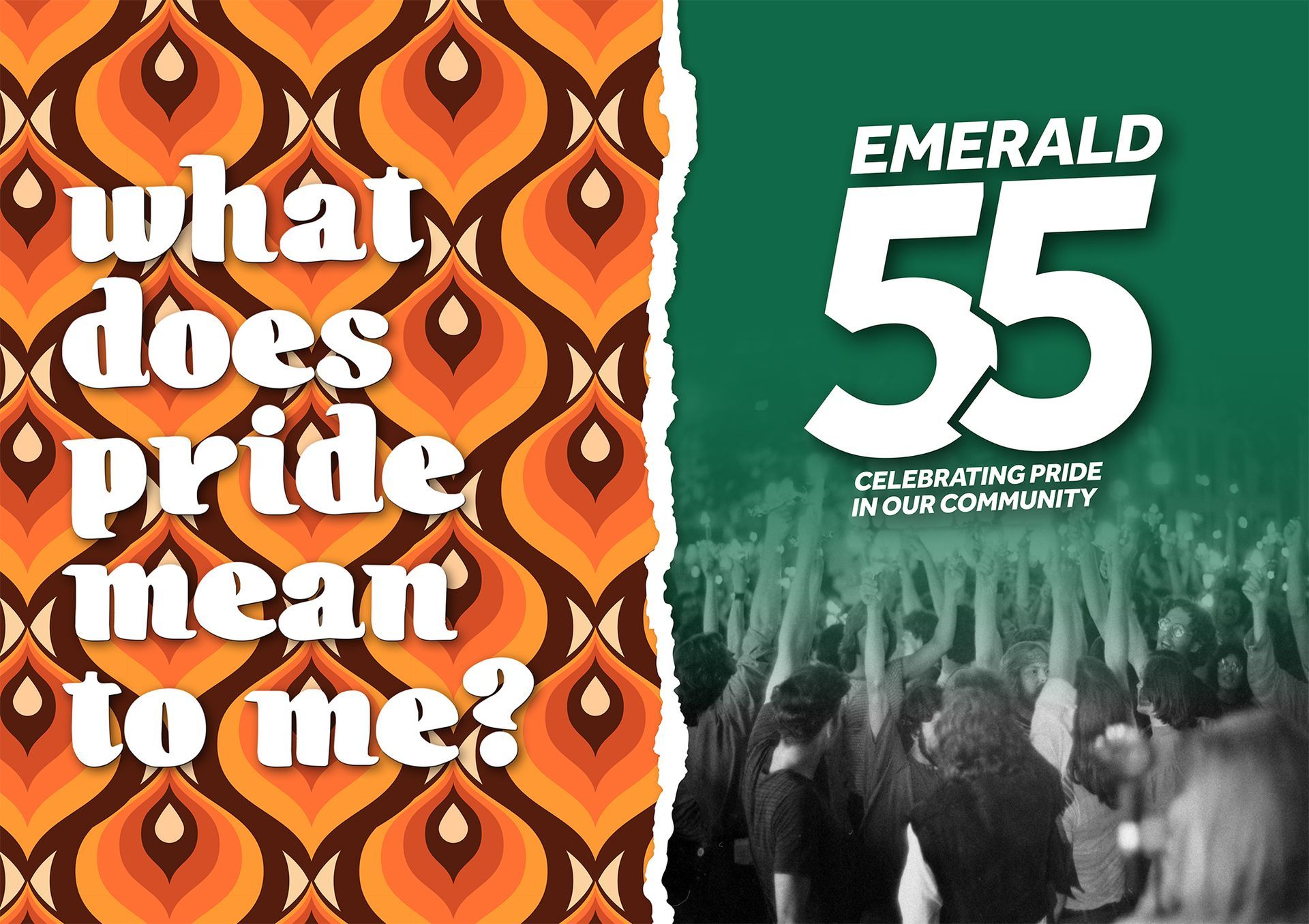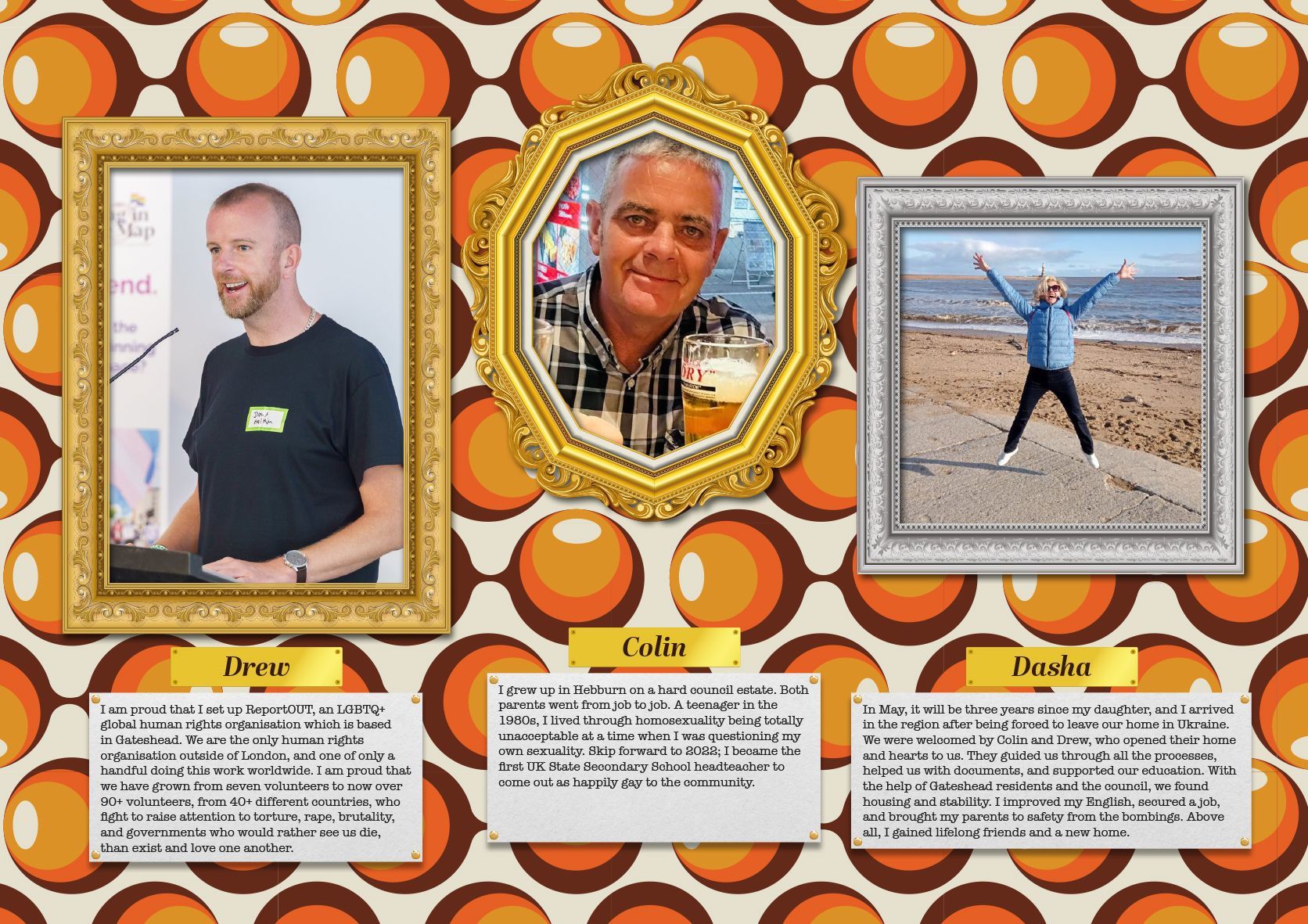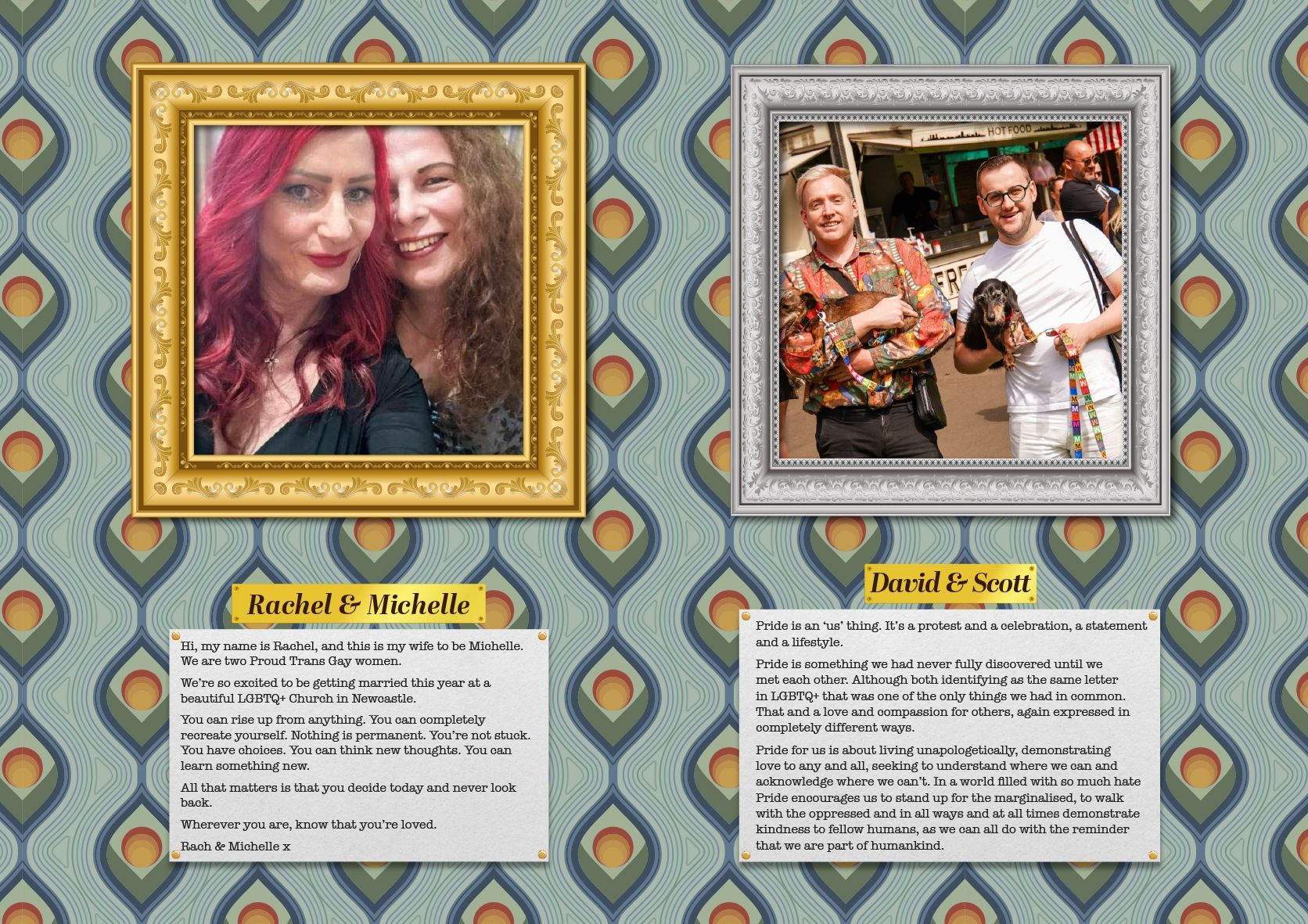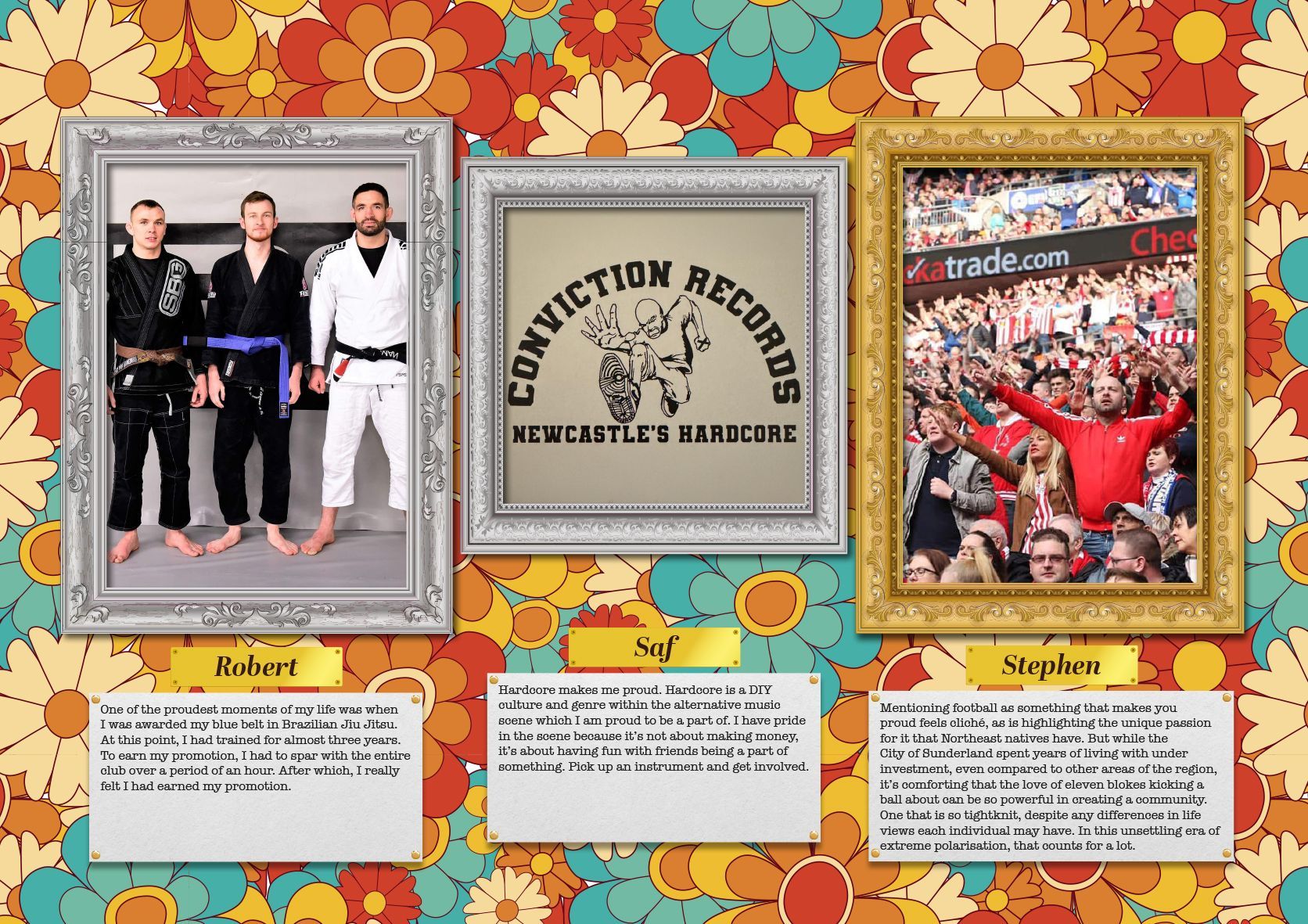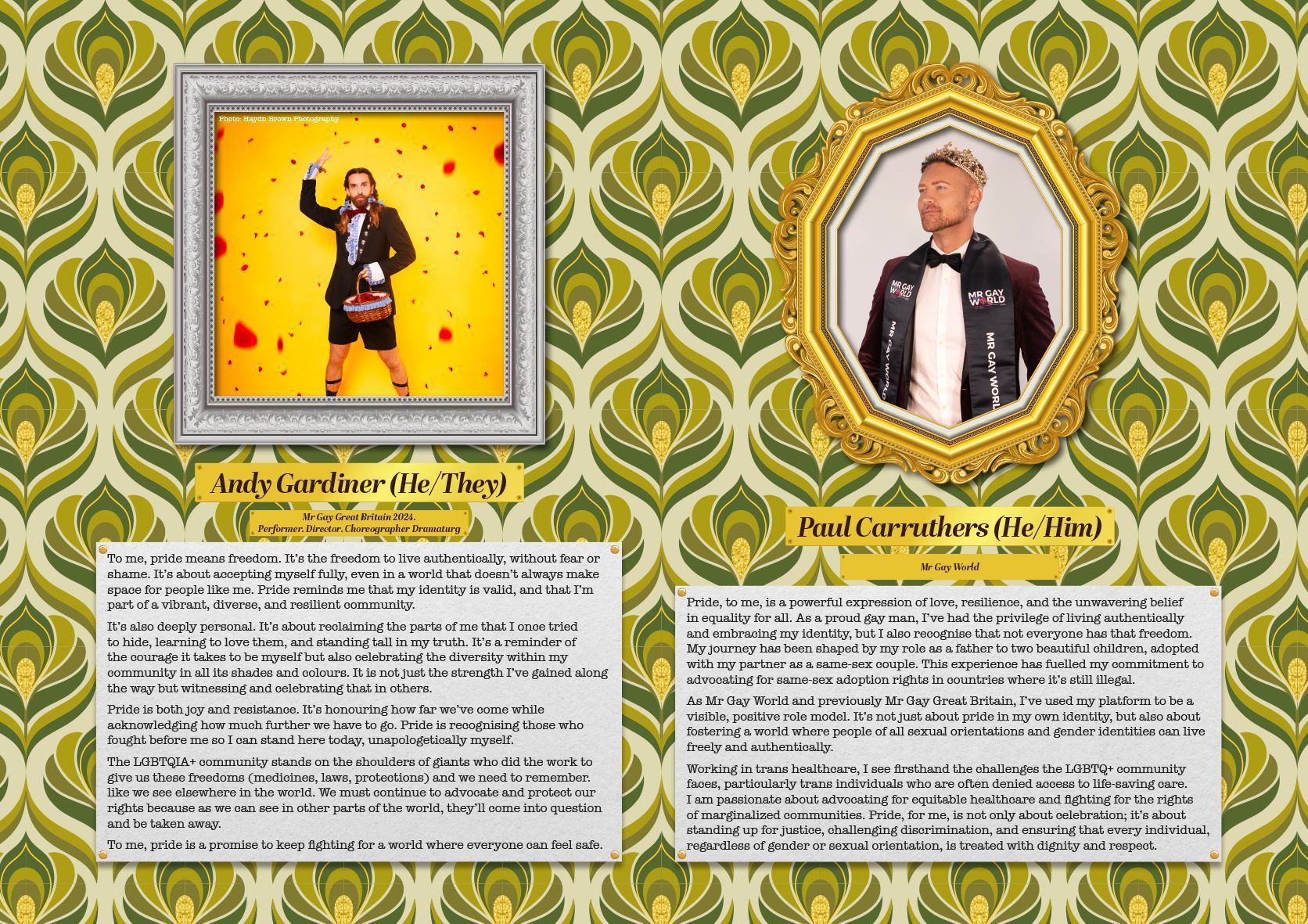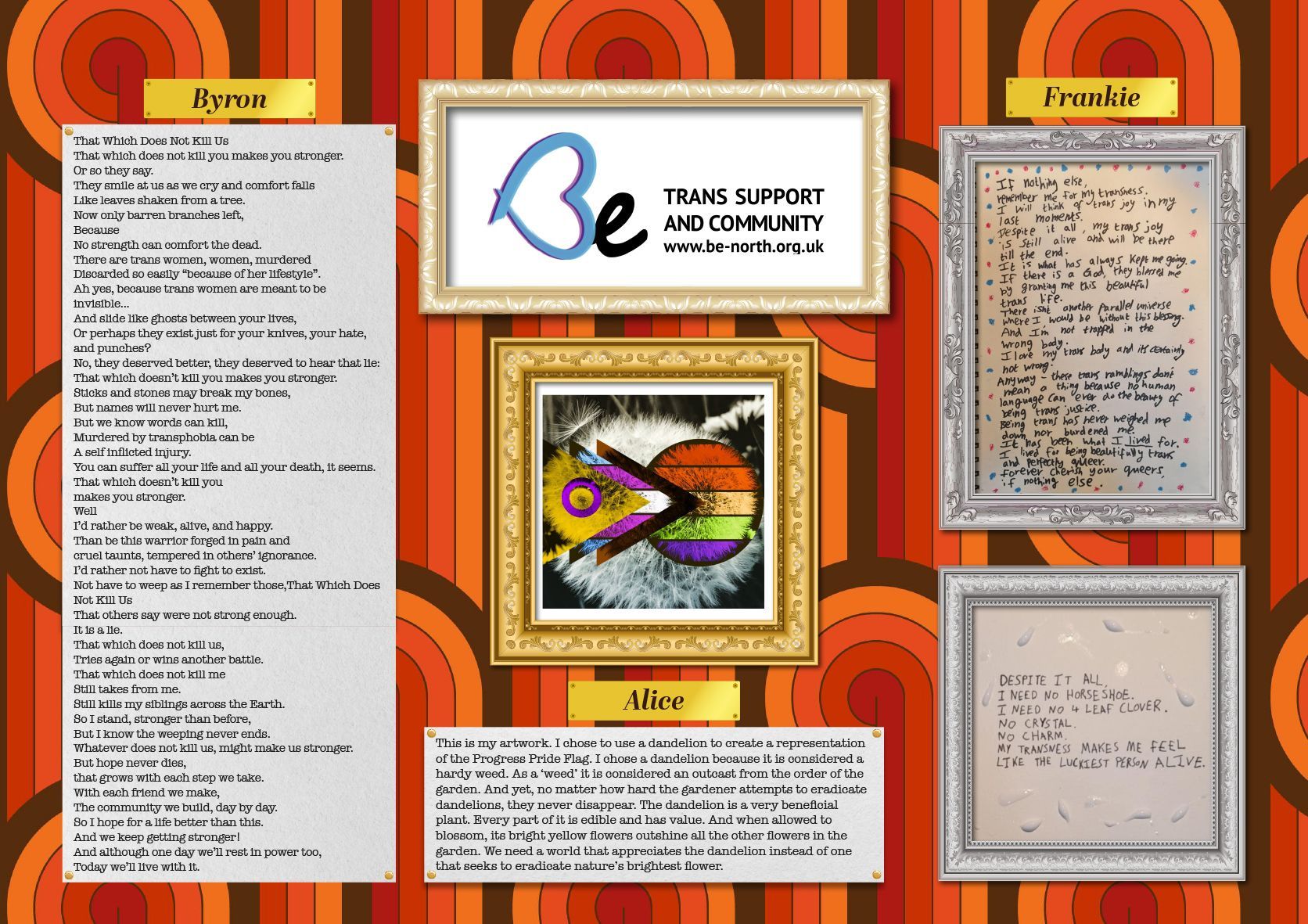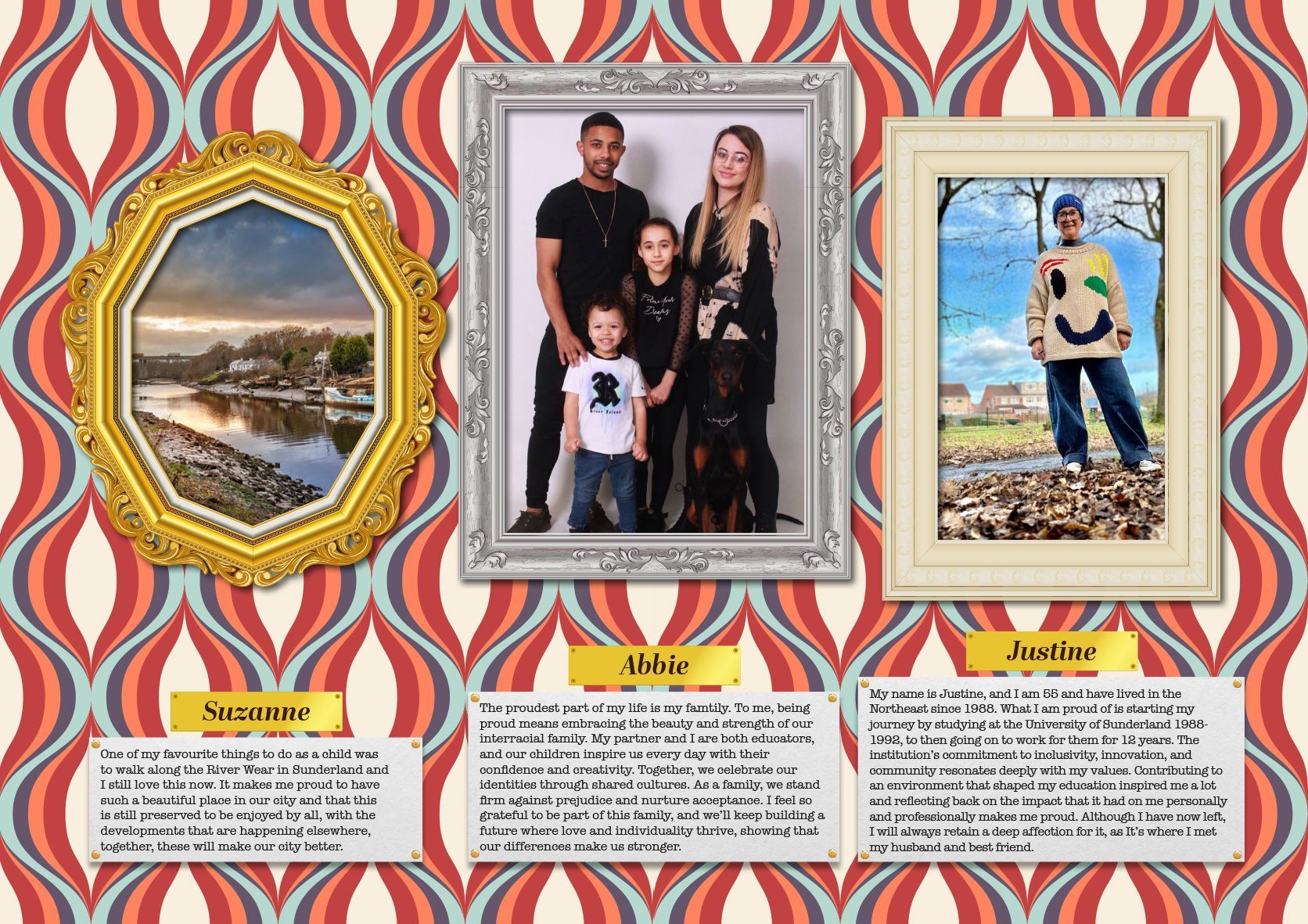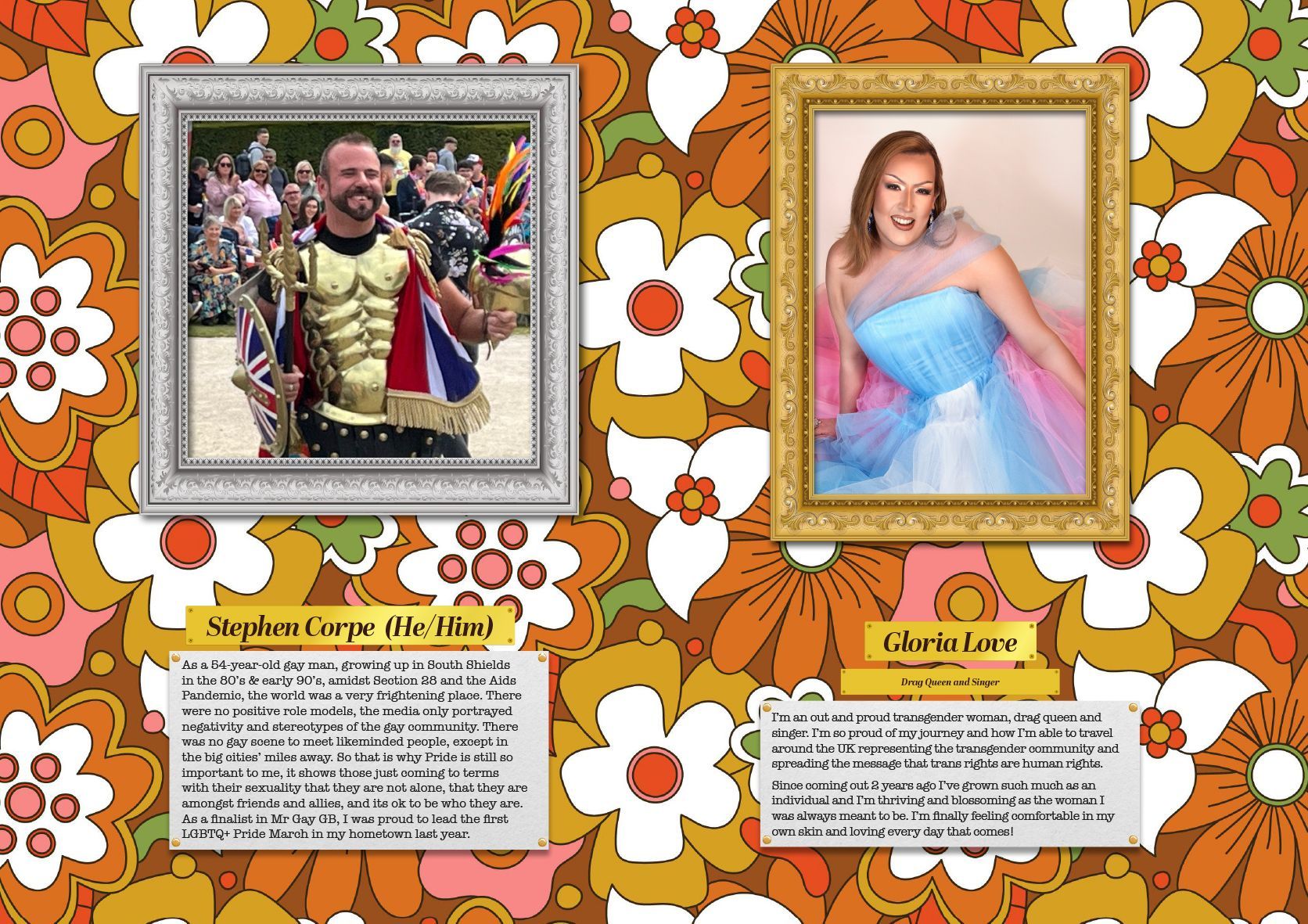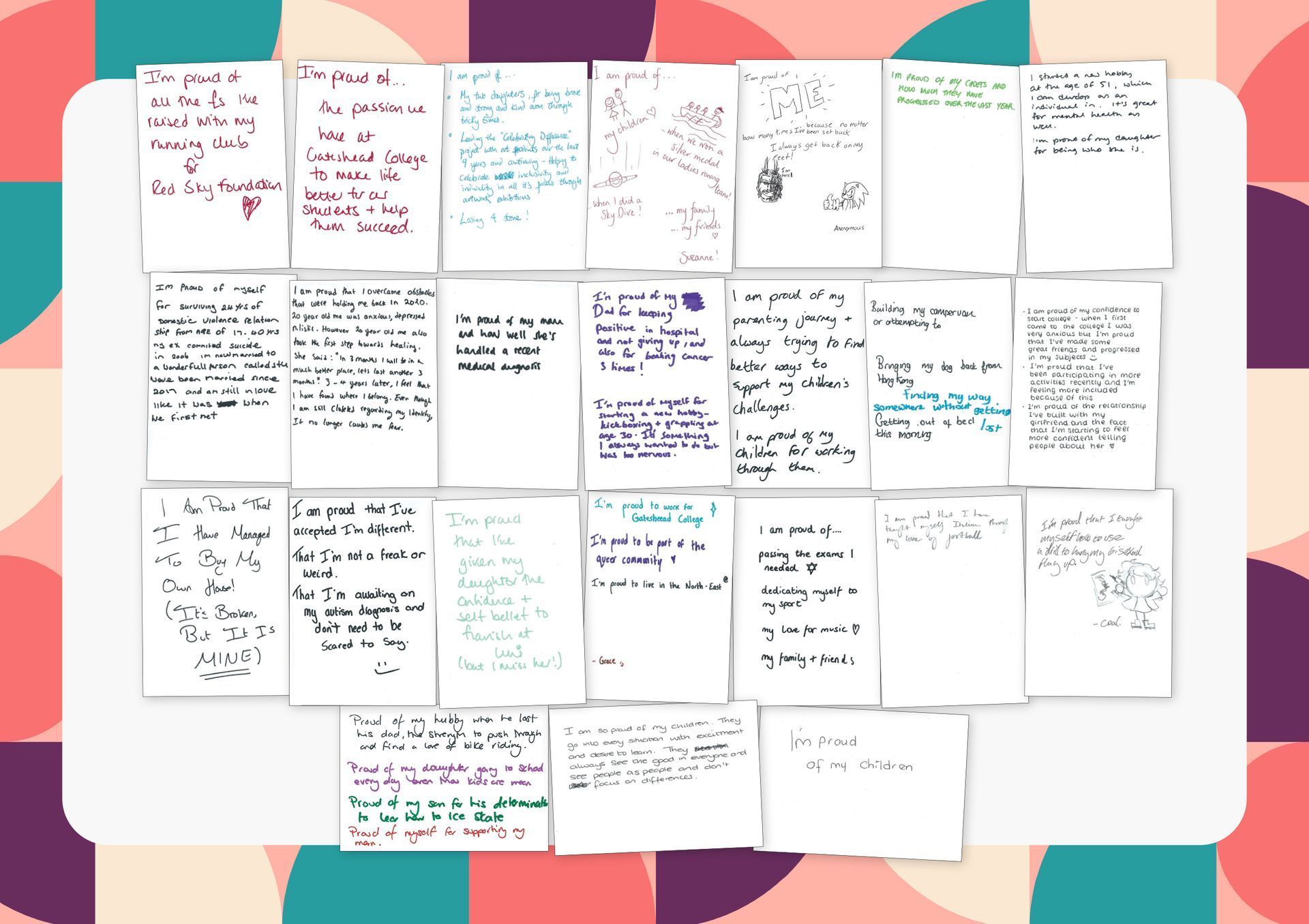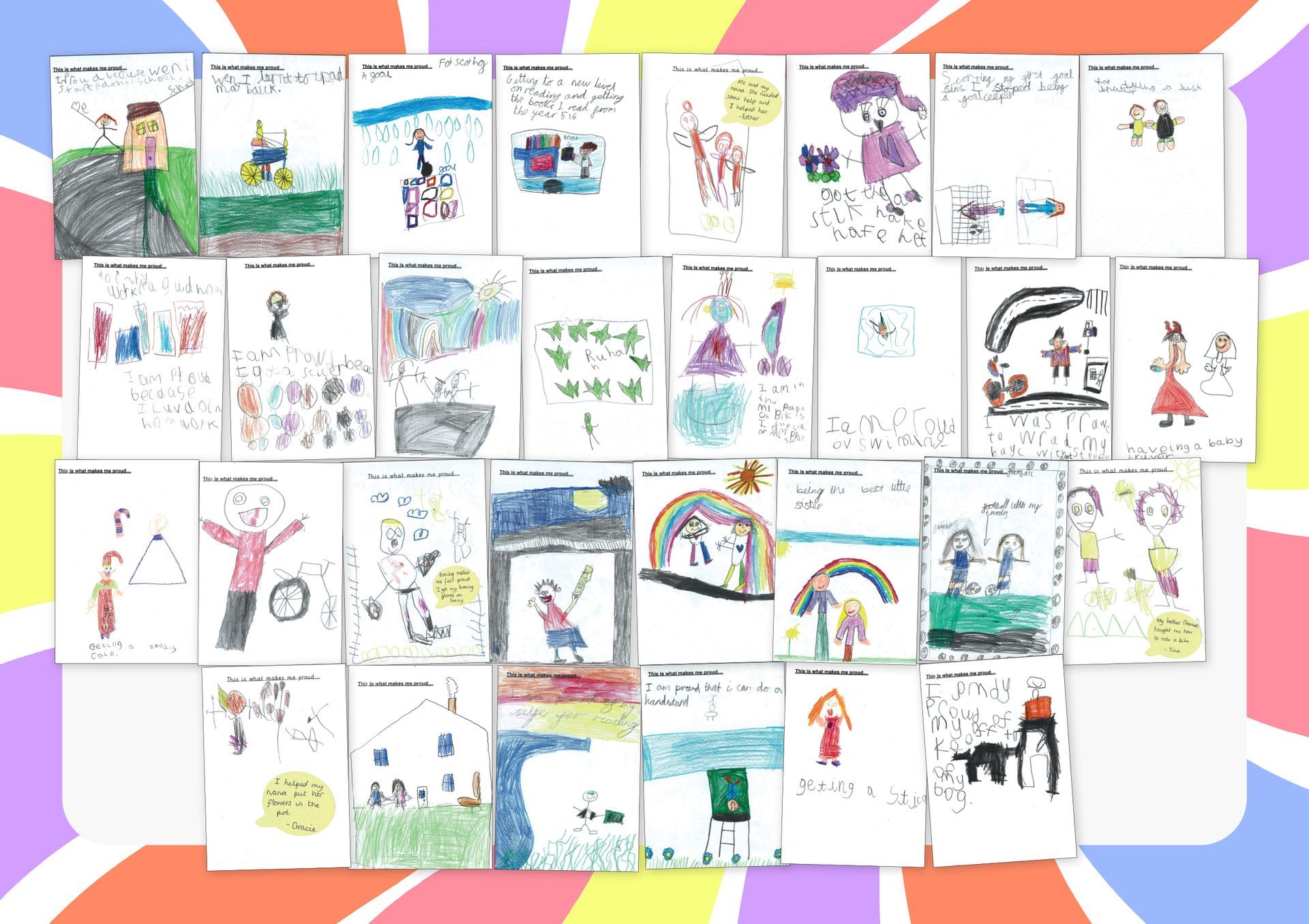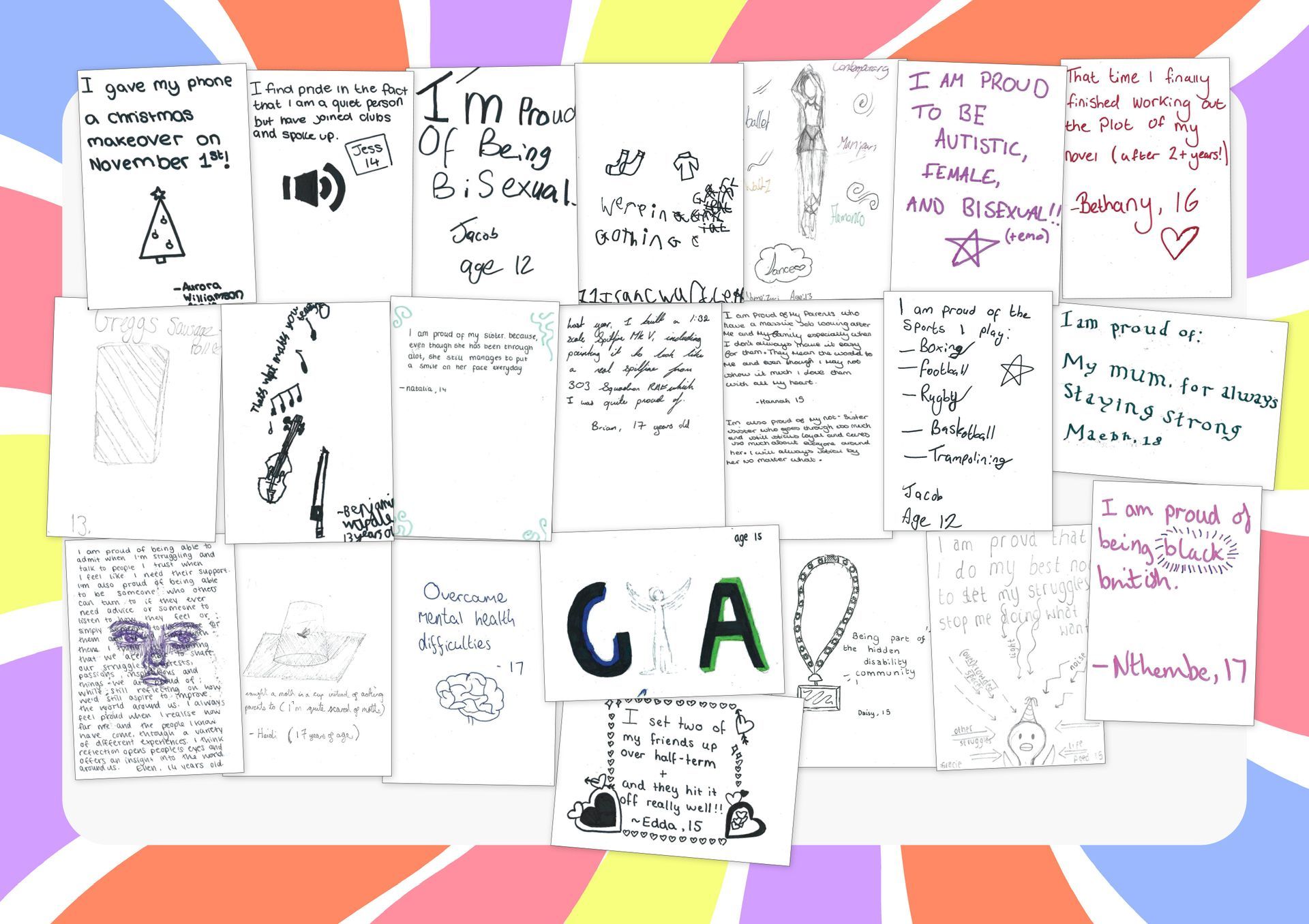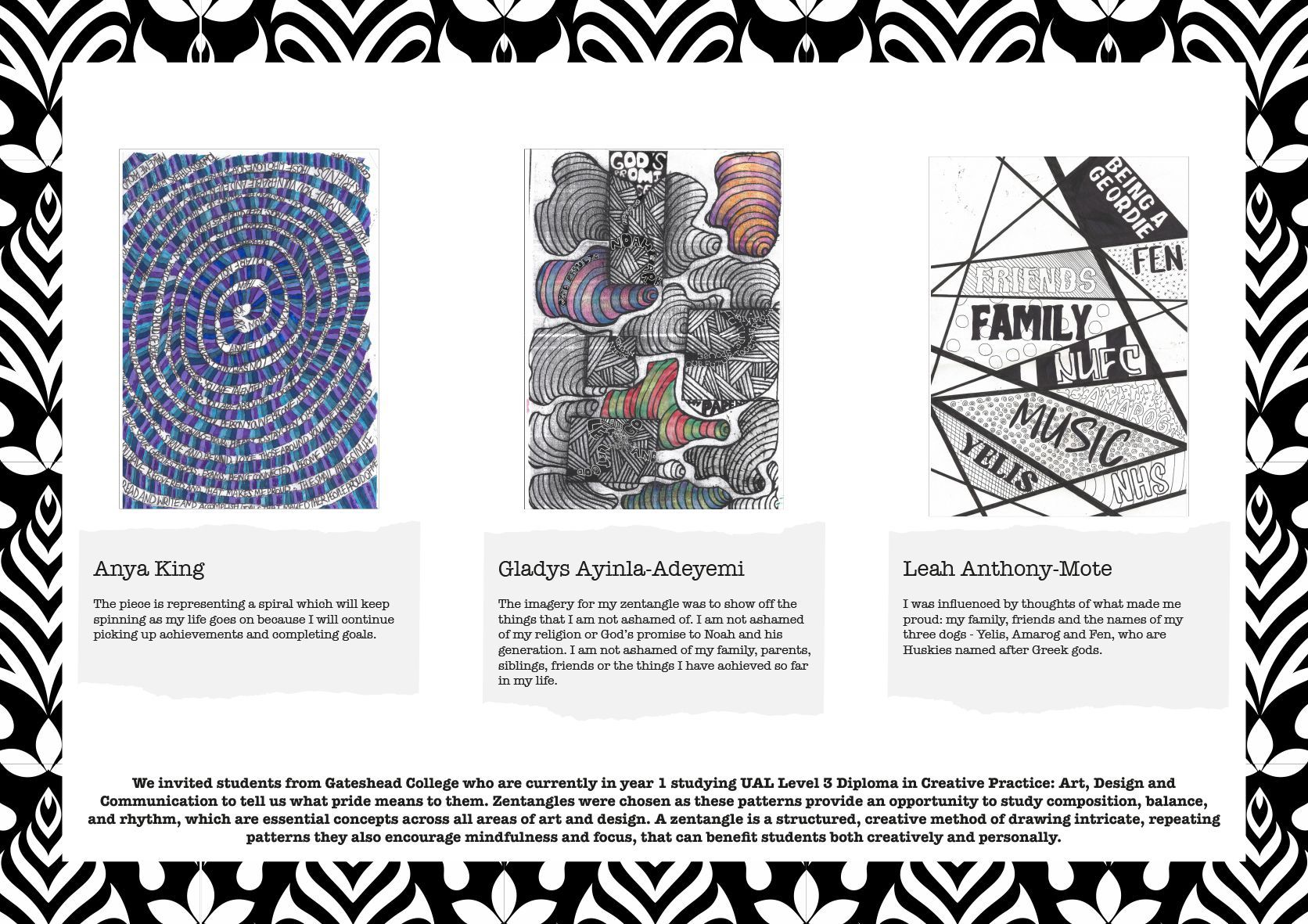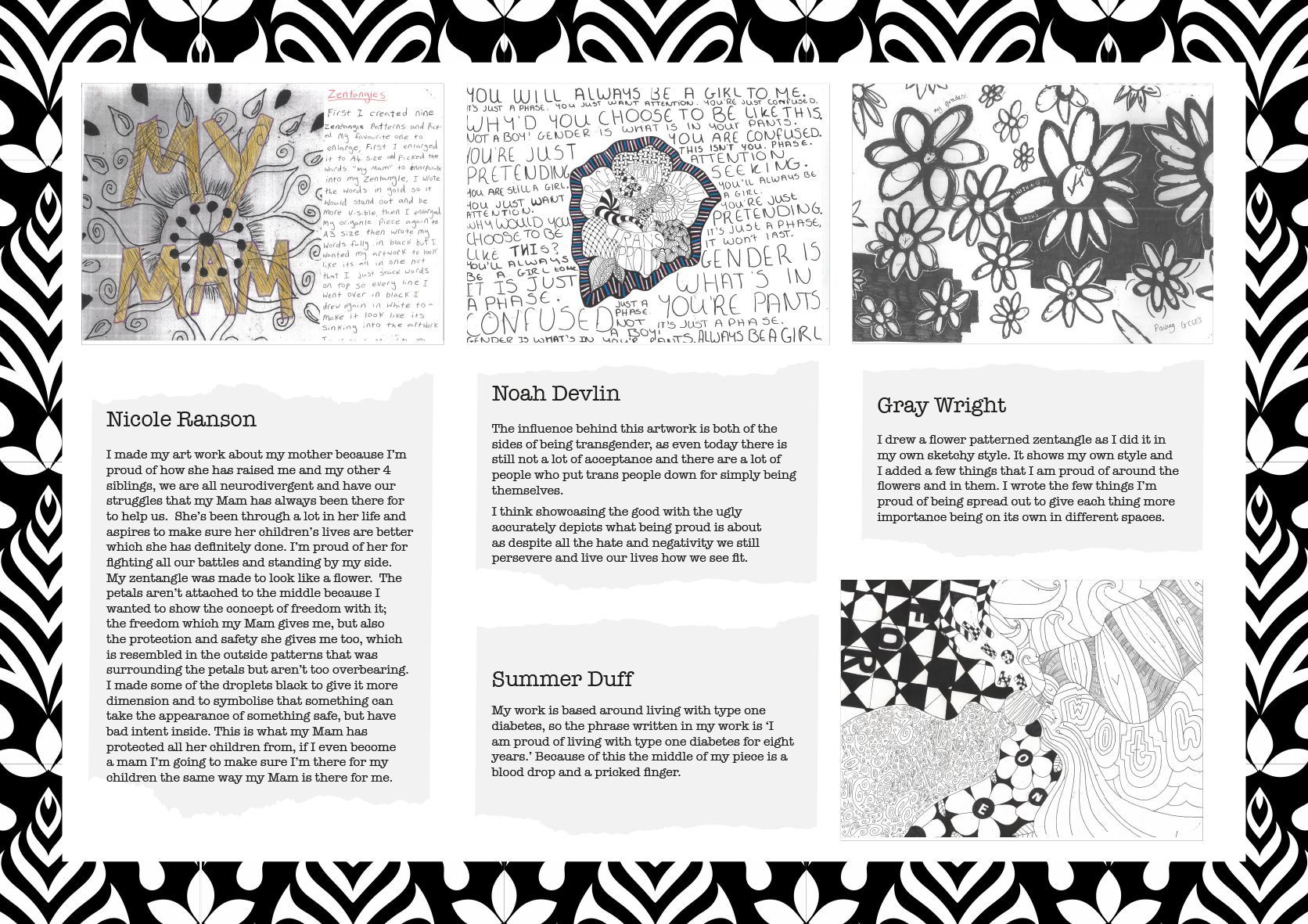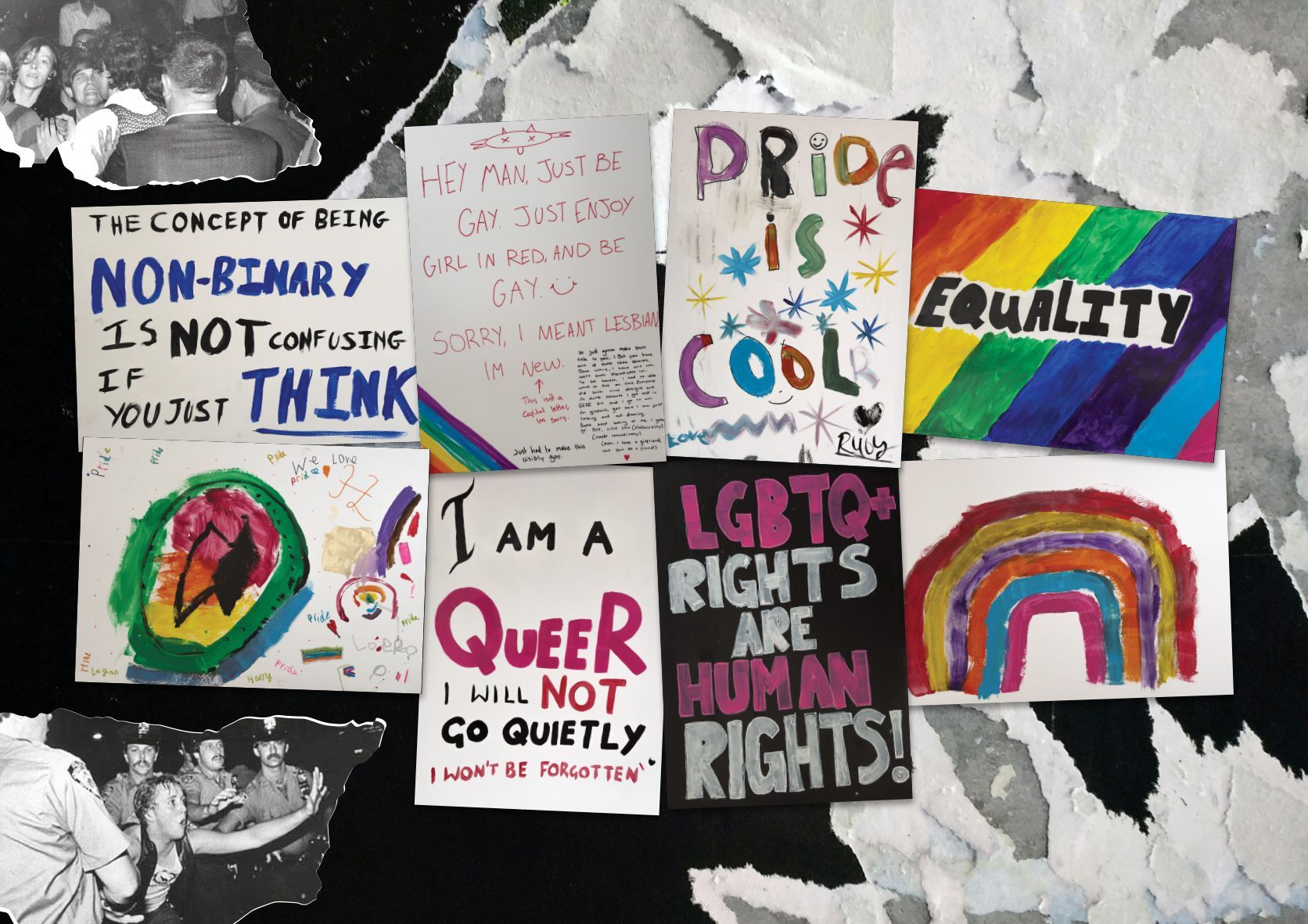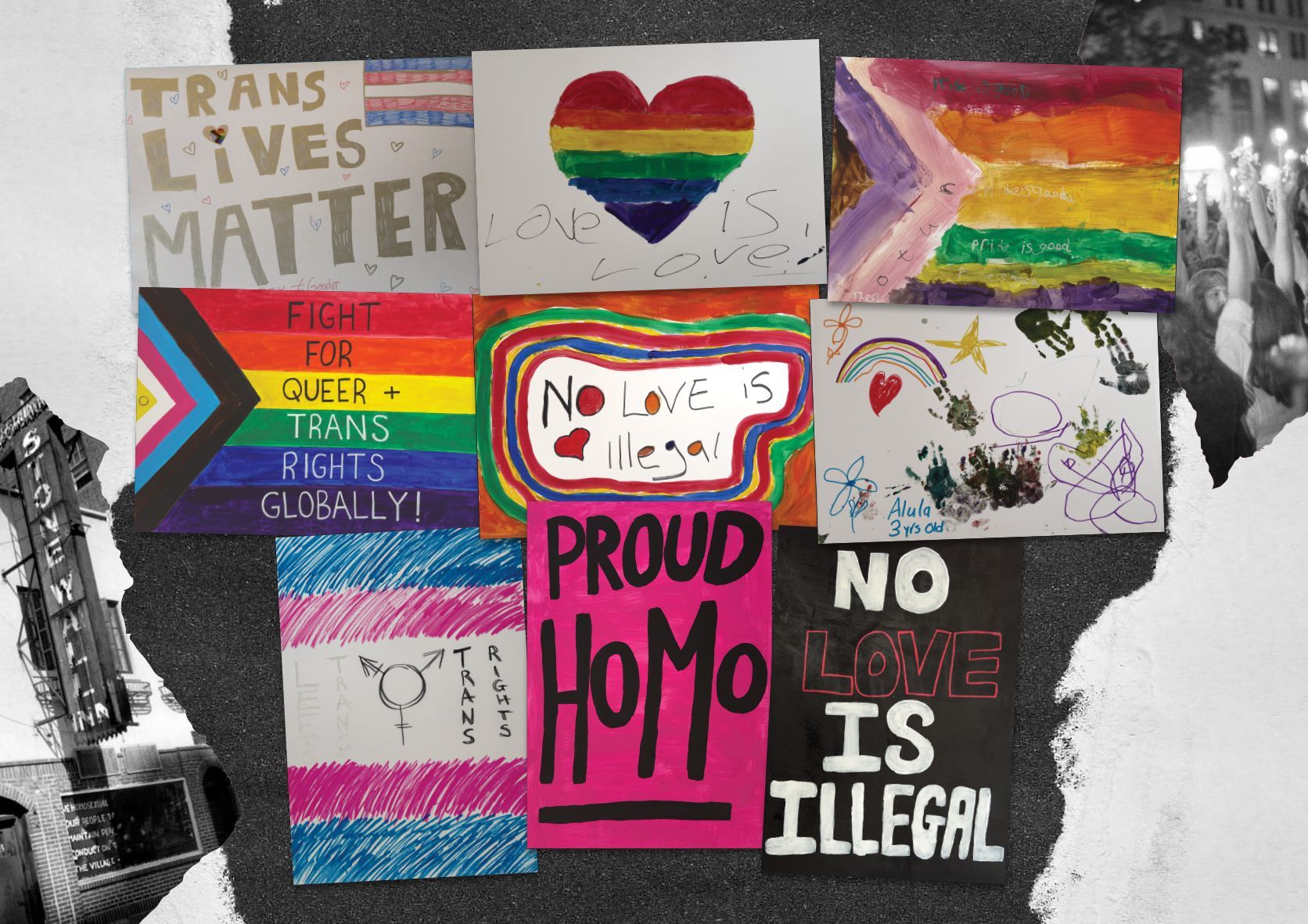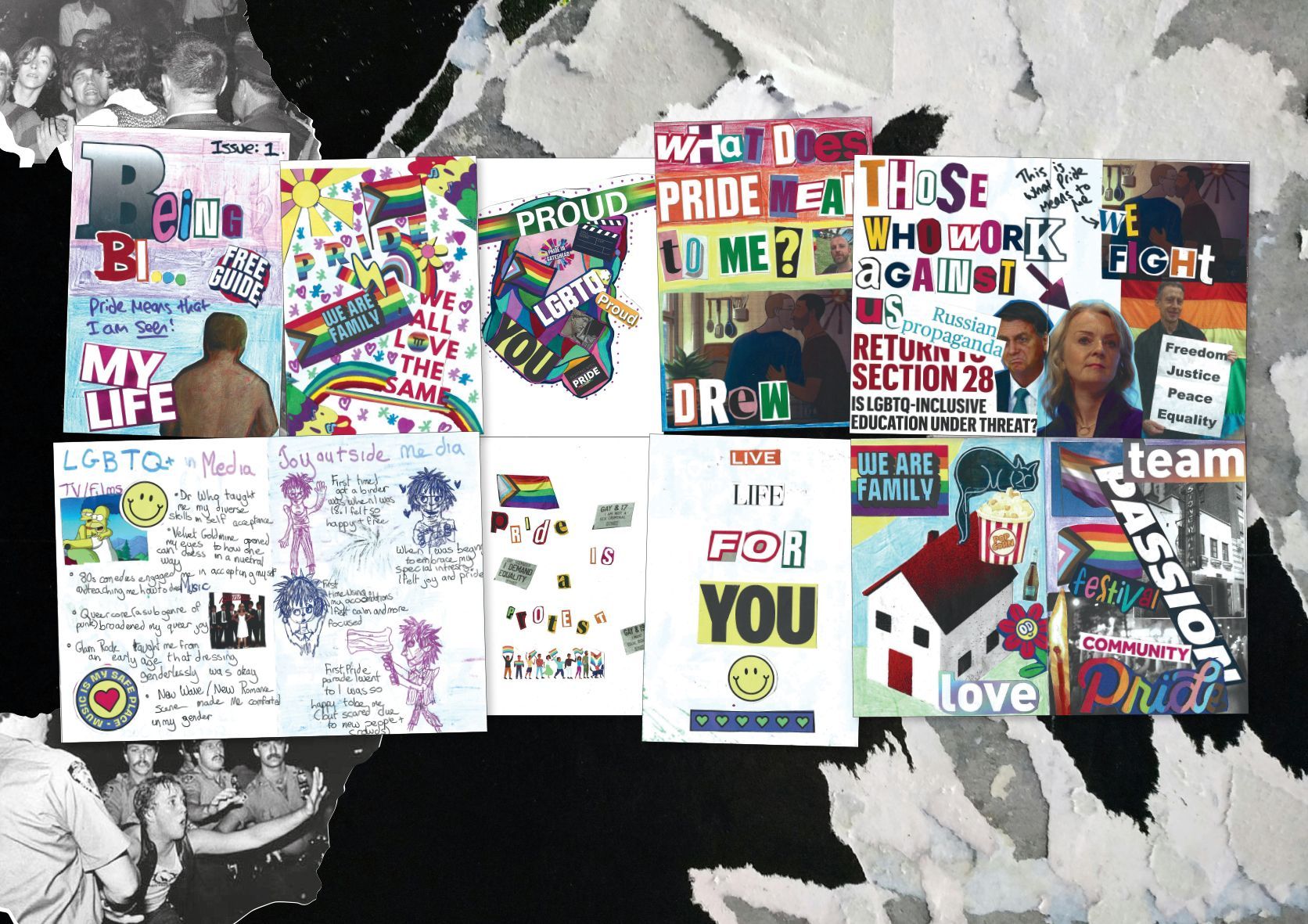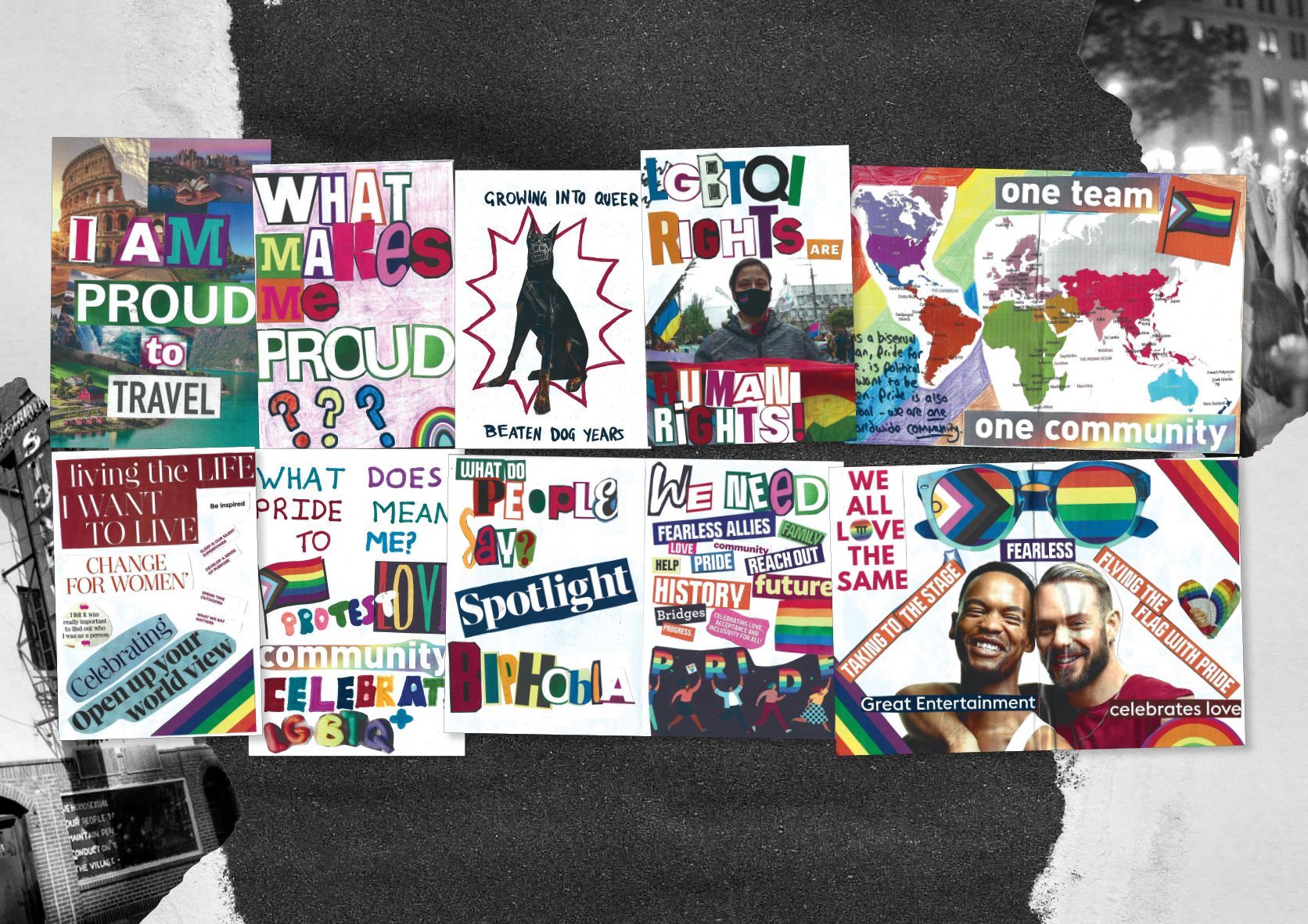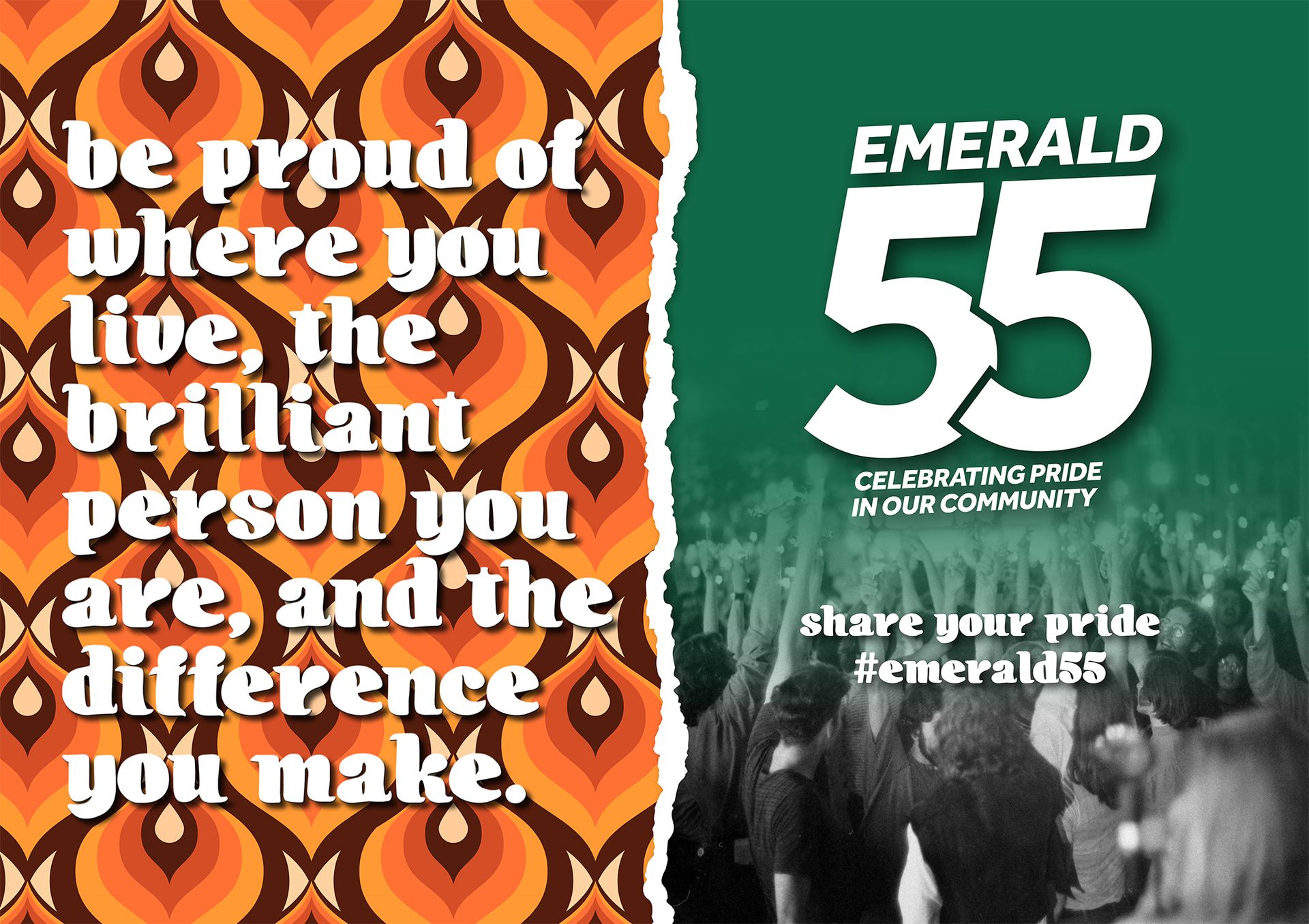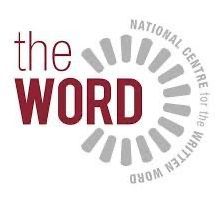
Welcome to Emerald 55, a celebration of Pride in our community.
My name is Peter and I’m the Chair of Out North East, an LGBTQ+ charity which has proudly produced this unique exhibition.
The idea for Emerald 55 came about purely by chance. In 2023, I was attending a Pride event and overheard a family questioning why so many in the crowd were dressed in rainbow flags. When I told them it was a Pride festival, the response was “oh, pride isn’t for us” and that comment stuck in my head.
I began to question what Pride meant to people and the idea for Emerald 55 started to develop. The Pride movement began in 1969 during The Stonewall Riots, a moment when the LGBTQ+ community fought back against decades of oppression and inequality. The first Pride march took place a year later in 1970 and it became a global rallying call for the LGBTQ+ community and our allies to fight for a more diverse, inclusive and open society for everyone.
Growing up in the 70s and 80s, I remember how difficult it was to be gay. There was no positive LGBTQ+ representation in the media, institutional homophobia was rife and a lack of understanding about AIDS and HIV led to horrendous bigotry to anyone suffering from this disease. We were also dealing with Thatcher’s Section 28 – a law which banned the promotion of homosexuality. Because of this, pride for me has always been about the fight for equality and for standing up for your right to exist.
Pride in its broader sense is an emotion we all experience – whether it’s pride in your football club, in a personal achievement or your sexuality or identity – it’s something that everyone can relate to. And it is these moments of pride – whatever they might be – which led to the creation of Emerald 55. Once we decided to produce this exhibition, we invited people from across the community to get involved. We held coffee mornings and delivered workshops, spoke with groups, talked to schools and colleges and interviewed people at Pride events over the summer. Hundreds of people took part, and this exhibition represents a small section of people’s thoughts and experiences. One of the questions we are frequently asked is why the name, Emerald 55.
There’s not one but three answers. Firstly the 55 relates to the 55th anniversary of the Stonewall Riots and an Emerald is the stone that marks this landmark anniversary. It’s also the colour inextricably linked with The Wizard of Oz and Judy Garland, an LGBTQ+ icon whose death in 1969 was one of the catalysts of the riots.
When we were curating the exhibition, it was important for us to connect the past to the present day. We chose popular retro wallpaper styles of the late 60s and 70s to link back to the riots and those first Pride marches in both the USA and UK.
I remember these wallpaper designs vividly as a kid and can still recall neighbours, who had recently decorated, proudly inviting the street into their homes to marvel at their bold choices. It seemed a perfect way to connect the pride we have in our past to the present. As you view the exhibition, you’ll notice the wallpaper gets torn to reveal protest statements underneath which is still at the heart of the Pride movement.
We also chose picture frames to display our messages which we all use to showcase a proud moment – a wedding, birth or personal achievement.
I’m really proud of Emerald 55 and our partners Sunderland Council, South Tyneside Council, Gateshead Council, Northumbria Police Crime Commissioner, Culture House Sunderland, South Tyneside and Sunderland NHS Foundation Trust, Nexus, Sorted PR, Bridges Shopping Centre, The Word, Gateshead College, Pride Radio and Potts Print for their support in making it happen.
I’m proud of Out North East and the team of creatives and volunteers who have worked tirelessly to create this exhibition.
But I’m most proud of the people who shared their stories. They make the region a rich and diverse place to live, work and visit and that’s something we can all celebrate and take pride in.

Peter Darrant
Chair
REMEMBERING STONEWALL:
THE STONE WALL RIOTS 1969
The Stonewall Riots took place on 28th June 1969 and are widely regarded as a watershed moment in the history of LGBTQ+ rights and the catalyst for the modern gay rights movement. It was a series of spontaneous demonstrations by members of the LGBTQ+ community against police harassment and discrimination at the Stonewall Inn, a gay bar in New York City’s Greenwich Village.
During the 1960s, LGBTQ+ individuals faced significant societal discrimination and legal persecution. Homosexuality was often considered a mental disorder, and same-sex relationships were criminalised in most US states. The few bars and clubs that served as safe spaces for the community were relentlessly targeted by law enforcement.
In the early hours of June 28, 1969, the police raided the Stonewall Inn, attempting to arrest employees and patrons for violating laws prohibiting same-sex relations, cross-dressing, and serving alcohol to LGBTQ+ individuals. While such raids were common during this time, the events at Stonewall would unfold very differently.
Members of the community had gathered to remember LGBTQ+ icon and Hollywood legend, Judy Garland who had passed away the week before.
Emotions were high and as the police entered the bar, tensions quickly escalated. The patrons, tired of being victimised and oppressed, and angry that their memorial was being disrupted decided to fight back. The raid sparked a spontaneous uprising fuelled by frustrations and anger over years of discrimination. The crowd began to resist and challenged the police officers, refusing to be arrested quietly.
Storme DeLarverie, a proud lesbian, drag king and lifelong gay activist is widely acknowledged to have thrown the first punch in protest though drag performers and trans activists Marsha P Johnson and Sylvia Rivera soon became the public faces of the protests.
What started as a confrontation between police and patrons quickly escalated into larger protests, with hundreds of people joining in solidarity over the following days. Protesters chanted, threw objects at the police, and fought back against the constant oppression they had endured.
The Stonewall Riots lasted for several nights, serving as a turning point in the fight for LGBTQ+ rights. The demonstrations garnered significant media attention and became a rallying cry for the emerging gay rights movement. Activists and community members mobilised, forming numerous advocacy organisations and demanding an end to the discrimination faced by the LGBTQ+ community.
In the aftermath of the riots, the Gay Liberation Front and the Gay Activists Alliance were formed, serving as important platforms for the advocacy and organisation of LGBTQ+ rights. Annual marches were initiated around the world to commemorate the Stonewall Riots and to continue the fight for equal rights. Pride Festivals, as we know them now, were established.
The impact of the Stonewall Riots cannot be overstated. It galvanised the LGBTQ+ community, empowering individuals to stand up against discrimination and demand equal treatment. It also helped change public perception, gradually leading to the decriminalization of homosexuality and the recognition of LGBTQ+ rights worldwide.
The Stonewall Riots were a pivotal moment, not only in LGBTQ+ history but also in the broader struggle for civil rights. The movement has since grown, achieving significant victories such as the legalisation of same-sex marriage and anti- discrimination legislation in many countries. However, the fight for LGBTQ+ rights remains ongoing, with continued challenges and obstacles to overcome.
The Stonewall Riots symbolise the power of collective action and the importance of standing up against injustice. They serve as a reminder that change is possible and that marginalised communities can fight for their rights, ultimately shaping a more inclusive and accepting society for future generations.
WHAT DOES PRIDE MEAN TO YOU?
Is it that sense of satisfaction from a job well done, a celebration of a child who has reached a goal or recognition of an achievement by a friend or colleague?
For the LGBTQ+ community pride has an additional meaning - it is synonymous with promoting their identity, their culture, their experiences and their history.
Pride manifests itself in many ways - and we invited the communities of Sunderland, South Tyneside and Gateshead to share their stories and personal experiences of what makes them proud.
If your school would like to stage its own Emerald 55 exhibition, download the
free education pack.
Emerald 55 would not be possible without the support of our amazing partners:

